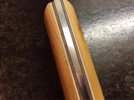Robert Erickson
Knifemaker / Craftsman / Service Provider
- Joined
- Feb 2, 2014
- Messages
- 2,865
I'm in the process of finishing up my first commissioned knife and have found a crack in one of the scales. The wood is pacific yew, it was stabilized by K&G and the crack is filled with resin so I can't do the CA glue trick to fill a gap. Can it be fixed? I thought about trying to use an razor blade to chip out the resin. I hope I don't have to grind the scales off and start over. Of course the person wants it by Christmas.

